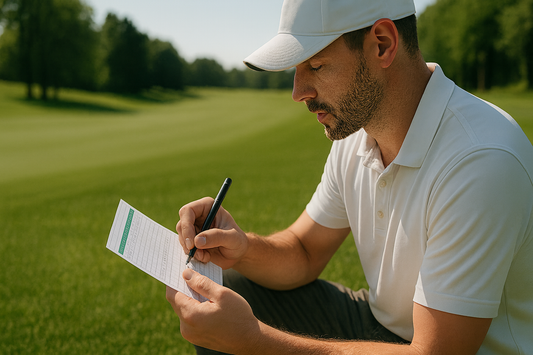I've been teaching golf for two decades, and I can tell you this much: golfers love their stats. Greens in regulation, fairways hit, putts per round - everybody's tracking something. But most of the numbers you're obsessing over? They're not telling you the whole story.
Strokes gained changed everything.
This isn't just another golf statistic. It's a complete reimagining of how we measure performance on the course. And once you understand it - really understand it - you'll never look at your game the same way again.
What Strokes Gained Actually Means
Forget everything you think you know about golf statistics for a minute. Strokes gained doesn't care how many fairways you hit or how many putts you took. It cares about one thing: did that shot make you better or worse compared to what we'd expect?
Every shot you hit gets measured against a baseline. That baseline? It's what scratch golfers typically do from your exact situation: same lie, same distance, same conditions. If you do better than that baseline, you gained strokes. If you do worse, you lost strokes.
Simple concept, but it reveals everything.
I had a student last year who was convinced his putting was terrible because he averaged 32 putts per round. Sounded awful to him. However, when we examined strokes gained putting, he was actually gaining 0.3 strokes per round on the greens. Why? He was getting closer to pins than most golfers, leaving himself easier putts.
Traditional stats would have had him working on putting technique. Strokes gained showed us his real problem was approach shots.
Why Every Other Golf Stat Lies to You
Traditional golf statistics are largely ineffective for improving one's game. Sounds harsh, but it's true.
Greens in regulation treats a shot to three feet the same as a shot to 40 feet. Both count as hitting the green. Strokes gained know that a three-footer is worth about 1.5 strokes more than a 40-footer.
Strokes gained measures the actual impact of where your ball ended up by comparing your expected strokes to finish the hole from that position.
Even the number of putts per round can mislead you. Take two golfers averaging 30 putts. One hits approaches to five feet all day. The other hits to 25 feet. Same putting average, completely different skill levels. Strokes gained sorts this out immediately.
The Four Categories That Tell Your Whole Story
 Strokes gained breaks your game into four parts: driving, approach, short game, and putting. Each one gets measured separately, then combined for your total strokes gained.
Strokes gained breaks your game into four parts: driving, approach, short game, and putting. Each one gets measured separately, then combined for your total strokes gained.
Driving covers your tee shot on par 4s and 5s. Not just distance - though that matters more than most golfers realize - but accuracy relative to the trouble you're facing. A 250-yard drive down the middle gains you more strokes than a 280-yard bomb in the trees.
Approach shots are everything from your second shot on par 5s to your tee shots on par 3s. This is usually where recreational golfers lose the most strokes. I see it every day: guys obsessing over their driver while bleeding strokes with their 7-iron from 150 yards.
Short game covers everything within 100 yards of the pin that's not on the green. Chips, pitches, bunker shots. The stuff that looks easy but destroys scorecards.
Putting measures everything once you're on the green. But unlike putts per round, it accounts for distance. A 30-foot putt that ends up three feet away? That's gaining strokes, even if you don't make it.
How the Numbers Actually Work
The baseline for strokes gained comes from millions of shots hit by scratch golfers. Every situation you can imagine - from distance to lie to pin position - is catalogued and averaged.
From 150 yards in the fairway, scratch golfers average getting their ball to about 20 feet from the pin, and they'll make their next shot (usually a putt) roughly 65% of the time. Their expected total strokes from that situation: 2.35.
You hit it to 10 feet? That position has an expected score of 1.85 strokes. You just gained 0.5 strokes with that approach shot. Hit it to 40 feet? That's 2.65 expected strokes. You lost 0.3 strokes.
The math happens automatically with tracking systems, but understanding the concept changes how you think about every shot.
What the Numbers Tell You (And What They Don't)
I work with golfers who obsess over their strokes gained numbers like stock prices. Daily fluctuations mean nothing. What matters is the trend over time.
Strokes gained putting between -0.5 and +0.5 per round? You're fine on the greens. Focus elsewhere. Losing more than a stroke per round on approaches? That's where you need work, regardless of how many greens you're hitting.
But here's what strokes gained can't tell you: why you're losing strokes. It identifies the problem areas perfectly. The solutions? That's where coaching comes in.
I had a member losing 2.5 strokes per round on approach shots. Strokes gained told us that much. Took three lessons to figure out he was using the wrong clubs for his distances. Stats identify, coaching fixes.
The Biggest Misconceptions About Strokes Gained
Everyone thinks you need some fancy system to track strokes gained. Wrong. Apps and even basic tracking on your phone can calculate these numbers. Some golf courses are starting to provide strokes gained data right on their apps.
Another myth: strokes gained only matters for good players. Actually the opposite. Higher handicappers see the biggest improvements once they understand where they're really losing shots. Most think it's putting. Usually it's not.
And don't get caught up in daily fluctuations. Golf is random. You'll have days where you gain three strokes putting and days where you lose two. Look at 10-round averages minimum.
How to Use This Information
Stop tracking fairways hit. Stop counting putts. Start paying attention to where you're gaining and losing strokes over time.
If you're losing strokes on approach shots - and most golfers are - that's your priority. Not your driver, not your putter. The shot that gets you from 100-180 yards into scoring position.
Losing strokes around the green? That's technique and practice, usually involving better contact and distance control. Gaining strokes off the tee but losing them everywhere else? Your course management might be too aggressive.
The beauty of strokes gained is it removes guesswork. Your improvement priorities become obvious.
My Honest Take on the Strokes Gained Revolution
After seventeen years of teaching, strokes gained is the best thing that's happened to golf instruction. Period. It cuts through all the noise and shows exactly where golfers need help.
However, and this is crucial, the numbers only work if you're honest about tracking shots. Fudging distances or not recording penalty strokes makes the data worthless. Garbage in, garbage out.
I've seen golfers improve their handicaps by 3-5 strokes just by understanding their strokes gained data and focusing practice time correctly. Not because they got dramatically better at golf, but because they stopped working on the wrong things.
Why You Should Start Tracking Today
Most golfers practice randomly. Hit balls at the range until you feel better about your swing. Work on putting because you had a bad day on the greens. Spend hours on the driving range because driving looks the most fun.
Strokes gained takes the guesswork out of improvement. It tells you exactly where you're losing shots and how much each area costs you. Then you can make informed decisions about where to spend your practice time.
Track your rounds for a month. Look at the averages. I guarantee you'll be surprised by what you discover. Most golfers are.
Your putting probably isn't as bad as you think. Your short game likely isn't as good as you think. And your approach shots? They're almost certainly costing you more strokes than anything else.
Golf is hard enough when you're working on the right things. Don't make it harder by guessing what needs improvement. Let the numbers show you exactly where to focus, then get after it.
The best part? Once you start thinking in strokes gained, every shot becomes a clear win or loss. No more wondering if that drive was good enough or if that approach shot was acceptable. The math tells you everything you need to know.





